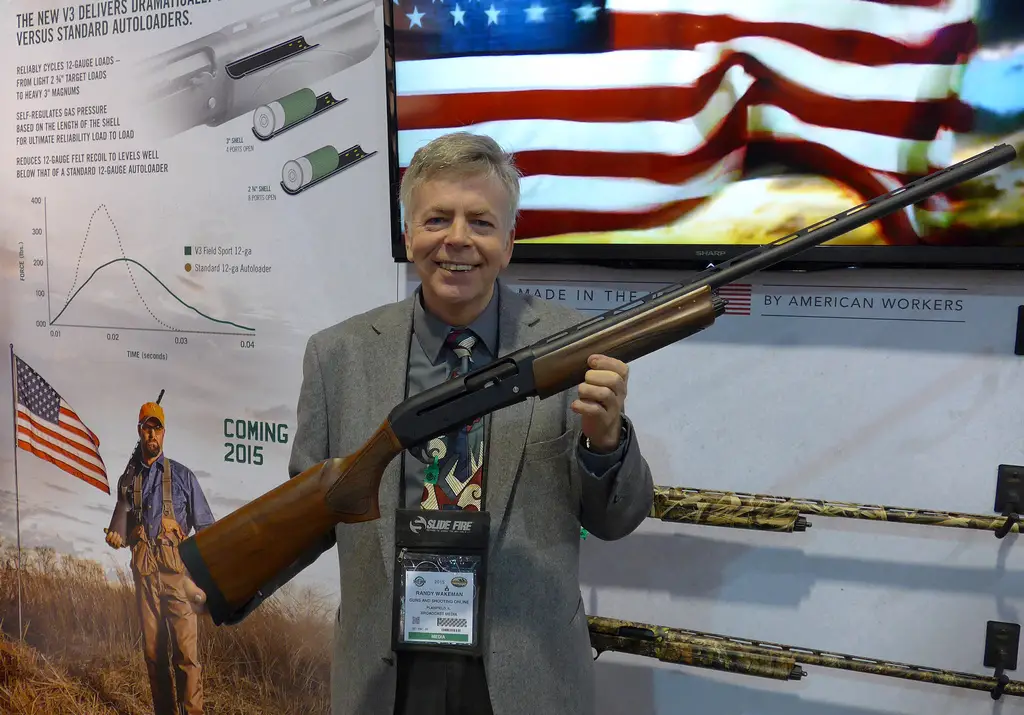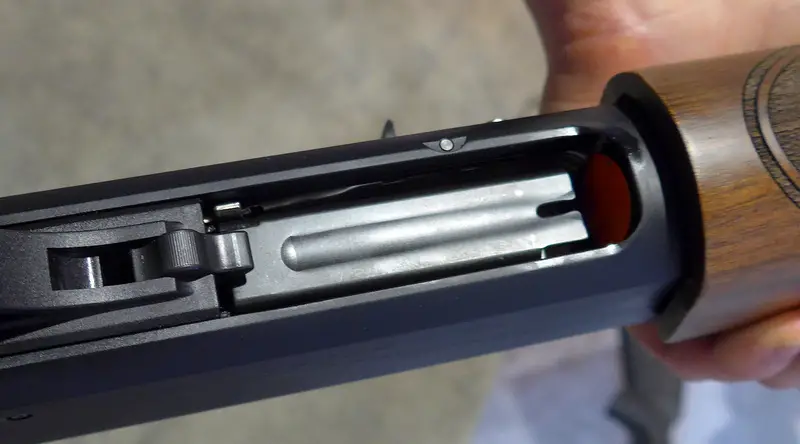


Review: Remington V3 Field Sport Autoloader, Finale (for now)
Good
autoloading shotguns are nothing new, for good autoloaders have always
shot reliably to the limit of the ammunition, more or less. While the
Browning Automatic-Five was and is a superb shotgun, the long recoil action
is not conducive to shooting everything with no adjustments. We don't
like to adjust things.
Fast forward to another one of my all-time favorite shotguns, the Beretta
A302 / Browning B-80 / Beretta A303. Good, tough, simple, and reliable:
but. The “but” is to shoot 2-3/4 inch shells, you should use
a 2-3/4 inch chambered barrel. If you want to shoot 3 inch shells, you
should switch barrels.
It is a very simple, easy system, but we don't like switching barrels. Still, even today, some are grousing because their 3 inch chamber B-80s and A303 don't work well with light target loads. They were never supposed to. The “just switch a barrel” idea does not play particularly well today, for replacement barrels are often ridiculously overpriced. A Beretta A400 field barrel runs $799.
Fast forward again to May 4, 1998, when the U.S. Army solicited submissions for a new shotgun. The winner was a short-stroke dual piston Benelli M4 Super 90, renamed the M1014. The Benelli inertia action was also tested and examined, but wasn't considered reliable enough. The Civolani inertia action needs recoil to function and historically has had a rough time with extremely light loads. The problem for a military application is weight: once you start adding rails, lasers, scopes, flashlights, other accessories to an inertia gun, it can become heavy enough to cease cycling. The M4 itself is a poor riot gun, for when shooting rubber buckshot loads it has to be manually cycled.
Now, off to the Versa Max and then the V3. Gas-operated shotguns can only partially compensate for different shells. They are only ported one basic way, the reason for the “switch barrel” B-80 / A302 / A303 approach, the reason for Rich Cole spring kits for the Beretta A390 and A391, the reason two different active valve pistons have been supplied with various F.N. SLP / Winchester SX2 / SX3 / Browning Gold models. Only one basic barrel porting configuration can be considered ideal for one particular application: the rest is compromise.
The Versa Max changed that, for by blocking off gas ports in concert with increasing unfolded shell length, the primary porting array does indeed change with the shell. In the V3, with its 3 inch chamber, there is even a more aggressive change: 8 ports open for 2-3/4 inch shells, but only 4 ports open for 3 inch shells. Now, after all these years, we finally have a “switch barrel” gas gun that switches porting automatically, with no user intervention. Although the gas actions are different, that's the easiest way to describe it: a B-80 with a 2-3/4 inch barrel and a 3 inch barrel, rolled into one gun as far as function.
The basic dual piston portion of the V3 action has been proven since 1999: it has a 16 year track record, and counting. That's why there just isn't much to worry about, as far as I'm concerned. It is a straightforward, simple approach in execution. I'm also not particularly mesmerized with the breechbolt return springs inside the receiver. It isn't rational to completely condemn the tongue at the back of the breechblock in mainspring approach, for the two most successful autoloaders in history, the A-5 and the 1100, have both managed quite well with them.
It is a better design, though, for it is simple . . . two springs on guide rods, and unlike a mainspring inside the buttstock, it is comparatively easy to irrigate, lube, and monitor. A buttstock mainspring is easily ignored, prone to build up of powder residue crud, and is rarely cleaned or lubricated.

REMINGTON V3 Frequently Asked Questions
Q.
Where is it made?
A. Ilion, New York. After proof-testing, the barrel is stamped with the
traditional Remington Star proof-mark.
Q.
When Can I Get One?
A. Officially, Remington has printed only “Coming 2015.” Naturally,
everyone at Remington would like to see it earlier rather than later,
but all the final details have not been decided upon yet. One example
of that would be the number of drop and cast shims supplied: it could
be four, or it could be as many as eight, I don't know. You can bet that
Remington has no plans to ship out incomplete guns, though, so although
details like this do not change the fundamental design at all, the shims
still have to be manufactured and packaged to ship shotguns. My best speculation
is July sometime for general availability, but that's just a guess.
Q.
Is the safety reversible for left-handed shooters?
A. Yes.
Q.
What choke tubes does it take?
A. The standard RemChoke. One choke tube, a Modified, is to be supplied
with the initially released models.
Q.
What don't you personally like about the V3?
A. I get asked that a lot! I'd like to see a more streamlined, logo-free
trigger guard treatment, although the size and shape are both quite good.
On the walnut model, I'd prefer that no sling stud be screwed into the
buttstock. As with all shotguns, I don't want a worthless center bead.
The V3 has one, but at least it is small enough to ignore. It can be unscrewed
and thrown away, my standard practice on hunting shotguns that have them,
regardless of brand. I'd like to see a 24 inch barrel option. With an
extended choke tube, it is a 25 inch barrel and that's ideal for pheasant
duty and makes for a slightly better handling gun in a turkey blind as
well.
Q.
How Reliable is the V3?
A. Over the the 3-4 year development cycle of the V3, Remington compared
it to all the major players in the autoloading shotgun market. Most are
familiar with the two basic failure to cycle modes: failure to eject and
failure to feed. Remington took this quite a bit deeper than that, identifying
something like thirty-six distinct possibilities that could cause a failure
to cycle and fire.
The design goal was come up with a 10% more reliable autoloader as compared to any other autoloader on the market. What they ended up with was a surprise to everyone at Remington, for the V3 proved to be 50% more reliable in their testing protocol than any other autoloader: 50% more reliable than the second place finisher, which was the Benelli inertia action.
Q.
I want a 20 gauge. Is this a possibility?
A. According to Remington, a 20 gauge is already in the works, but it
isn't expected out until 2017.
Q.
What is the printed warranty for the V3?
A. Two years.
Q.
Do the VersaPort ports plug up?
A. No, as demonstrated since 1999 in the M1014. The gas flowing through
the V3 ports, unlike a farther downstream gas action, is at high pressure
(8000 PSI area) and high heat (around 4500 degrees F.) As a result, the
VersaPorts are essentially high-pressure power-washed with every shot.
The higher temperature gas moving through them does not allow for the
particulate matter to solidify. Another advantage of the high pressure
port / dual short-stroke piston action is that the barrel can be made
as short as desired, without affecting function.

Q. What does the magazine cut-off do for me?
A. It prevents shells from leaving the tubular magazine by deactivating shell-stop movement. The tubular magazine is blocked off by the shell elevator that moves approximately into the center of it. The above image shows the magazine cut-off in activated condition. Back in the day, the gun of choice in this area was the Browning Automatic-Five 2-3/4 inch, throwing lead at ducks. We used #5 or #6 lead for mallards, but it was standard practice to keep a couple of #2 lead goose loads in your shirt pocket. The Auto-Five has a magazine cut-off on the left side of the receiver. So, if you hear a goose, the magazine cut-off is activated, the chambered shell is quickly jacked out, and in goes the goose load. A magazine cut-off allows for instant shell changes without disturbing the contents of the magazine, whether for a goose or for an unlucky coyote.
Q. What is going to be different on production guns vs. the tested prototype?
A. I don't really know. I suspect that the V3 production triggers will have a bit less take-up than the already excellent prototype's example. The walnut version of the V3 will have a conventional, ground pad . . . not the SuperCell as shown in the top image, as the SuperCell cannot be ground to a perfect fit. The production guns will have shims for cast and drop, but I'm not sure how many. The production guns might also have buttstock spacers to adjust the length of pull. I've not heard of any other changes of significance.
I'm reticent about reviewing preproduction guns as a rule, as significant changes may be made before the actual retail product begins to ship. Although that might be the case with the V3, it is highly unlikely that the basic action is up for any changes. Things already mentioned, like the number of included shims and so forth, are not yet fully decided upon, but the basics of the first three production models and their pricing of about $750 - $850 street, according to Remington, are not going to change.
Copyright 2015 by Randy Wakeman. All Rights Reserved.

Custom Search



